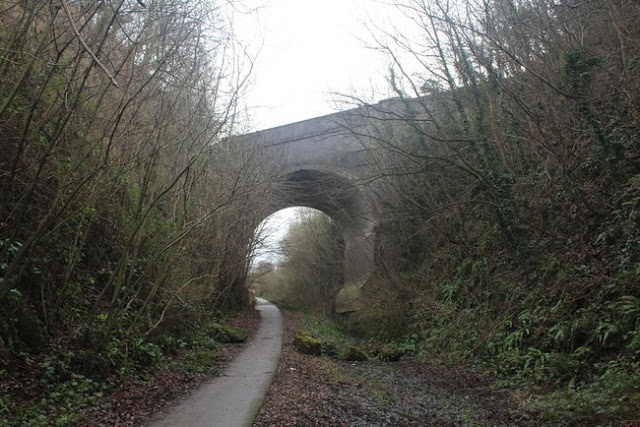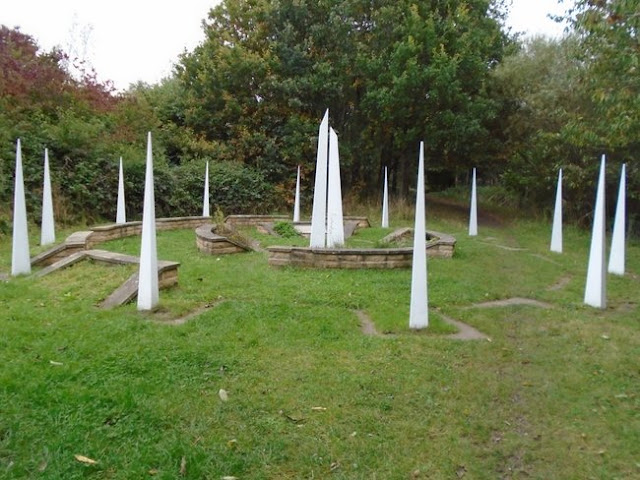Starting Point - Goldthorpe Station. Finishing Point - Potteric Carr Nature Reserve, Doncaster.
Distance - 12.5 Miles.
Continuing my walk of the Dearne Valley Railway I got a train to Goldthorpe to pick it up where I finished on the previous walk from Crofton to Goldthorpe.
At Goldthorpe a stretch of the line had survived in to the 1990s to serve Goldthorpe Colliery using a chord that connected to the Leeds to Sheffield line.
Below - Video found on YouTube of the last coal train from Goldthorpe Colliery.
From Goldthorpe station I headed along Barnsley Road to the bridge over the DVR, this bridge survives though is filled in now. The cutting must have been very deep at this point as the Wath branch of the Hull and Barnsley Railway also crossed under Barnsley Road at the site of the B6098 junction before crossing over the DVR.
Below - Barnsley Road bridge.
A park is being established in the railway cuttings through Goldthorpe but at the time of my visit this was fenced off so I had to walk along the roads nearby.
Below - Straight Lane bridge.
Below - Filled in High Street bridge.
Below - View west along the cutting from High Street bridge.
From Barnbrough Lane (now spelt Barnburg) the footpath that connected to Goldthorpe Colliery survives, now serving the houses built on the former colliery site. The metal footbridge seen in the 1990s video is still in use. From here the former trackbed itself is accessible. With the DVR ceasing to be a through route in 1966 loading facilities for the colliery were built where the through lines had once been. Some of the concrete foundations for these metal structures can still be seen.
Below - Remnants of Goldthorpe Colliery.
It was just east of the colliery, just before the Barnburg Lane bridge that the truncated line survived until the 1990s and this is evident from the surviving ballast.
Below - Trackbed east of Goldthorpe Colliery with ballast still in situ.
Below - Barnburg Lane bridge.
Just east of the bridge a concrete lineside hut survives, this is around the site of the signalbox.
Below - Lineside hut.
Below - Green Lane bridge.
Another park occupies the site of Barnbrough Main Colliery, this is quite a recurring theme on this route.
Passing Harlington the cutting has been filled in but the path still follows the course of the railway. Hollowgate is crossed at road level, as is Church Lane. At Church Lane the metal girder of the burried bridge can be seen.
Below - Filled in and buried Church Lane bridge.
The site of Harlington Halt has been built on, a footpath from Church Lane connects to Crane Moor Close which joins Harlington Road (now Doncaster Road) where the railway would have crossed on a bridge. South of Doncaster Road the trackbed has been built on and a detour is necessary along Mill Lane to pick up the path along the River Dearne which joins the trackbed further south.
The bridge over Pastures Road has been removed and the path diverts to the road. The Denaby Ings Nature Reserve occupies the site of Denaby Halt, a building on the station site is accessed by a staircase where the steps up to the westbound platform would have been. At the back of the building there are bits of concrete and wood that may have been part of the steps for the eastbound platform and at ground level a brick gatepost can be seen. There are also a few stubs of upright sleepers in the ground that were probably for retaining the hard standing area for the grounded 4 wheel coach body that served as a waiting room.
Below - Site of Denaby station. At the bottom of the photo a concrete fence post can be seen, behind it is a length of old rail that looks to have been used as a gate post.
Below - Picture of one of the Railmotors at Denaby Halt in 1929 from the Conisborough and Denaby Main Heritage Group website.
Approaching Conisborough the landscape has changed considerably. The River Dearne has been diverted, presumably to prevent the flooding on the earlier maps. Clay pits and colliery spoil have also been landscaped over. After crossing an overflow from the ponds of the wetlands to the river (which looks like it could be an obstruction if water was overflowing) and passing through a wooded area I picked up the Transpennine Trail path. The railway ran alongside the path to the north and a footpath seems to follow the course of the railway. North of Kingswood Dearne Valley (in the former Earth Centre) a roadway was been built on the trackbed when Cadeby Main Colliery was still in use. Remains of the facilities for loading coal lorries can be seen amongst the fly tipped rubbish.
Below - Site of Cadeby Main Colliery.
Below - Sleepers at the site of Cadeby Main Colliery.
Below - Constitution Hill bridge.
The DVR crossed over tunnels of the Hull and Barnsley Railway's Denaby Branch and the Swinton to Doncaster line which is still in use. On the north side of the roadway the H&BR tunnel mouth can be seen. I gather some have ventured in to the tunnel but it emerges in to a quarry site. The roadway heads towards the quarry but the course of the DVR is followed through the stone bollards and on to Conisborough Viaduct.
Below - Cadeby Tunnel on the former Hull and Barnsley Railway's Denaby Branch.
Below - Conisborough Viaduct.
Below - Doncaster Road bridge. Though this looks like a typical blue brick bridge over the railway at a distance up close it looks more modern, possibly the road has been widened in later years.
The cutting has been filled in but the footpath follows the course of the line up to where the Gowdall and Braithwell line crossed over on a bridge. Beyond there the DVR route is now in industrial use. The trackbed of the Gowdall and Braithwell line is now a road called Warmsworth Halt, I followed this to Edlington Lane. The only evidence that it was once a railway with sidings and a goods yard were the concrete fence posts on the north side of the road.
Heading south along Edlington Lane back to the course of the DVR, the site of Edlington Half is now occupied by the fire station. Edlington was the terminus of the passenger service from Wakefield. Described as "Edlington for Balby Doncaster" it can hardly be claimed to have served the latter. Of course this route was all about the coal, as evident from some of the most minimal stations ever seen.
Beyond the fire station the sports facilities that owe their existence to the nearby mines that were once here survive. A path leads through to the railway trackbed.
Below - Lord's Head Lane bridge.
At Broomhouse Lane the bridge has been removed. Certainly some people have climbed the embankment at the other side of the road, though it only continues as far as the A1M where there is no bridge over the motorway. I continued along Broomhouse Lane to Aldcliffe Cresent to pick up the path on the other side of the motorway. The sidings of Yorkshire Main Colliery were along Broomhouse Lane. This mine lasted until 1985 and a stub of the DVR east from here remained in use to serve it.
On the way to pick up the trackbed on the other side of the motorway I looked down Grange Lane where the bridge survives.
Below - Grange Lane bridge.
Below - Springwell Lane bridge.
A widened A60 with a roundabout junction has resulted in a stretch of cutting being filled in. One side of the filled in bridge can be seen.
Below - Filled in Balby Road bridge.
Below - Footpath bridge.
Below - Hall Balk Lane bridge.
Where White Rose Way has been built across the trackbed there is a walk around the road junctions to the entrance to Potteric Carr Nature Reserve. There is an entry fee to the reserve and a visitor center at the entrance has a cafe, shop and toilet facilities. The reserve has been established around Doncaster's railway version of Spaghetti Junction. The junction was redesigned in the 1970s to reuse the bridge that carried the South Yorkshire Joint Railway over the DVR for a new freight line to the sidings on the middle left of the old map. The access to the surviving section of DVR was from the chord shown on the old maps as No 10 section, heading south on to the South Yorkshire Joint Railway. The DVR up to Black Carr East Junction, where it met the still existing freight lines is one of the paths within the reserve. No 10 and No 11 section chords are also now footpaths. It his hard to visualise how the DVR reached the SYJR bridge that crossed over it. Originally the chord from the South Yorkshire Joint Railway to the sidings on the left of the old map (shown without track on the map) was on a much higher embankment. The footpath along the DVR crosses under the chord using the same bridge as the Mother Drain, originally this bridge would have been much higher and a separate bridge north of it would have carried the line over the DVR. The height of the chord was reduced to meet the later freight lines passing under the SYJR lines.
Below - Sign from Low Ellers Junction signal box in Potteric Carr Nature Reserve. Low Ellers Junction was situated north of the East Coast main line where another chord branched off the SYJR for trains heading towards Doncaster.
Below - Bridge that used to take the South Yorkshire Joint Line over the Dearne Valley Railway. Beneath the middle span is now occupied by freight lines towards Doncaster.
Below - Bridge that took the No 11 Section joint line over the Mother Drain.
From here I walked in to Doncaster for a train home, though this was a more complicated walk than some of the earlier detours off the trackbed as pedestrians don't seem to have been thought of when the retail parks in the area were planned. Google Maps also suggested I should walk on a busy road without pedestrian access. The journey in to Doncaster took about 45 minutes so it is probably better to check out bus connections from the nearby retail parks.






























































